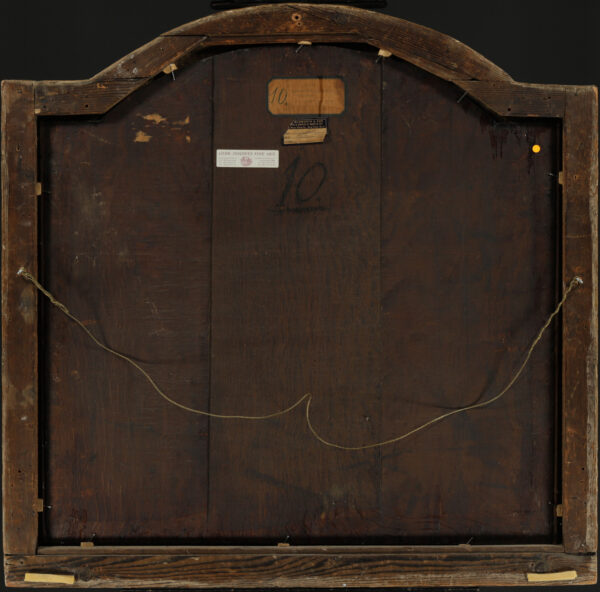“A Pronk Still Life with a Silver Tazza, a Silver-gilt Columbine Cup, a Flute Glass, Oysters, a Wan-Li Dish, a peeled Lemon, Vines and Grapes, and a knife and shrimps on a plate, all placed on a table laid with a velvet Cloth”, ca. 1650-1655
Oil on arched panel: 81/68,5 x 83 cm;
signed with monogram AvB (on the side of the table, left)
"*" indicates required fields
Notes
Abraham Hendriksz van Beijeren was a Dutch Baroque painter of still lifes. Little recognized in his day and initially active as a marine painter, he is now considered one of the most important painters of still lifes, and still lifes of fish and so-called ‘pronkstillevens’, i.e. sumptuous still lifes of luxurious objects.
While in the 1640s most of his paintings were seascapes, van Beijeren began to develop as a skilled still life painter of fish. In his early marine paintings he shows the influence of Jan van Goyen.
In the 1650s and 1660s he started to focus on pronkstillevens, i.e. still lifes with fine silverware, Chinese porcelain, glass and selections of fruit. He also painted a number of floral still life paintings, dead bird paintings and vanitas paintings. The move to painting pronkstillevens may have been motivated by economic necessity as they could be sold to a wealthier clientele. These still lifes are often quite elaborate displays and show the influence of Jan Davidsz. de Heem.
He generally used a fairly broad technique and brown tonalities with some precision of detail. Van Beijeren was likely familiar with the other Dutch painters of pronkstillevens such as Pieter Claesz and Willem Claeszoon Heda who were specialists in monochrome banquet still lives. He often worked on a larger scale than his Dutch contemporaries with his tall canvasses reaching a height of one meter.
Important collections & museums that include works by the artist:
The Scottish National Gallery, the Academy of Fine Arts Vienna, the Ashmolean Museum (University of Oxford), the Iris & B. Gerald Cantor Center for Visual Arts (Stanford University, California), the Cleveland Museum of Art, the Dallas Museum of Art, the Detroit Institute of Arts, Museum de Fundatie, the Honolulu Museum of Art, the Los Angeles County Museum of Art, the Louvre, the Metropolitan Museum of Art, the Minneapolis Institute of Arts, the National Maritime Museum (Greenwich, UK), the York Art Gallery, York, UK; the Philadelphia Museum of Art, the Rijksmuseum Amsterdam, the Royal Museums of Fine Arts of Belgium, the Rhode Island School of Design Museum, the Royal Castle in Warsaw and the Seattle Art Museum are some of the public collections that hold paintings by Abraham van Beyeren. In private collections: Ger Eenens Collection the Netherlands.
Provenance:
- coll. William A. Coats, Dalskairth, Dumfries, Scotland;
- Major J.A. Coats, Skalmorlie Castle, Scotland (old label on verso);
- Galerie Sanct Lucas, Vienna with Petit Croise;
- Inc. Schaeffer Galleries, New York City/Berlin, before 1953;
- collection Dr. L.D. van Hengel, “Huize Dalsteijn”, Ellecom near Arnhem;
- his deceased estate sale (Notary Q. van de Velde, Dieren, May 1953, cat.no.347, with ill.);
- collection Stefels, The Netherlands;
- since then by descent in private collection;
- P. de Boer, Amsterdam at TEFAF 2001;
- with Douwes Fine Art, Amsterdam at TEFAF 2006;
- private Dutch collection.
Literature
- Art News, 25 May 1940, p, 17,ill on p.9
- To be found at the RKD or Rijksbureau voor Kunsthistorische Documentatie under no. 12977
Exhibitions
- Great Dutch Masters, New York, 1936, no. 2, with ill;
- Dutch and Flemish Paintings, Amsterdam, no.7, with ill;
- Dutch Paintings, Rhode Island School of Design, Prondence, Dec. 1938, with ill;
- Golden Gate International Exposition, San Francisco, 1939, no. 69, with ill;
- Grand Rapids Art Gallery, Grand Rapids, May 1940;
- Amherst College, Massachussetts, 1941;
- University of Indiana, Bloomington Indiana, March 1942, no. 69;
- Great Dutch Masters, Duveen Galleries, New York, 1942, no.1, with ill.;
- Art Association, Montreal, March 1944, no. 62;
- Allen Memorial Art Museum, Oberling, Ohio, March 1945





